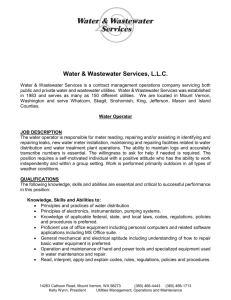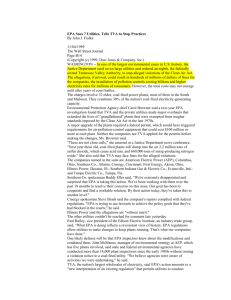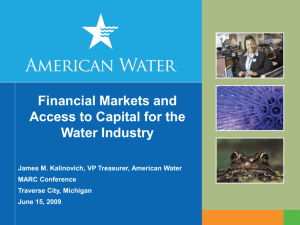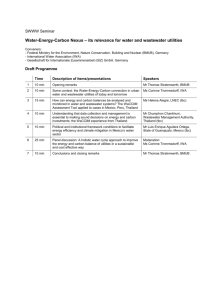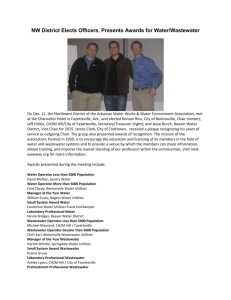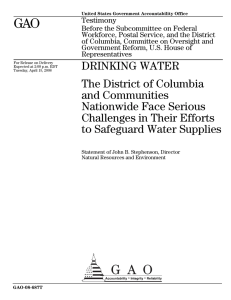Sustainable Infrastructure
advertisement
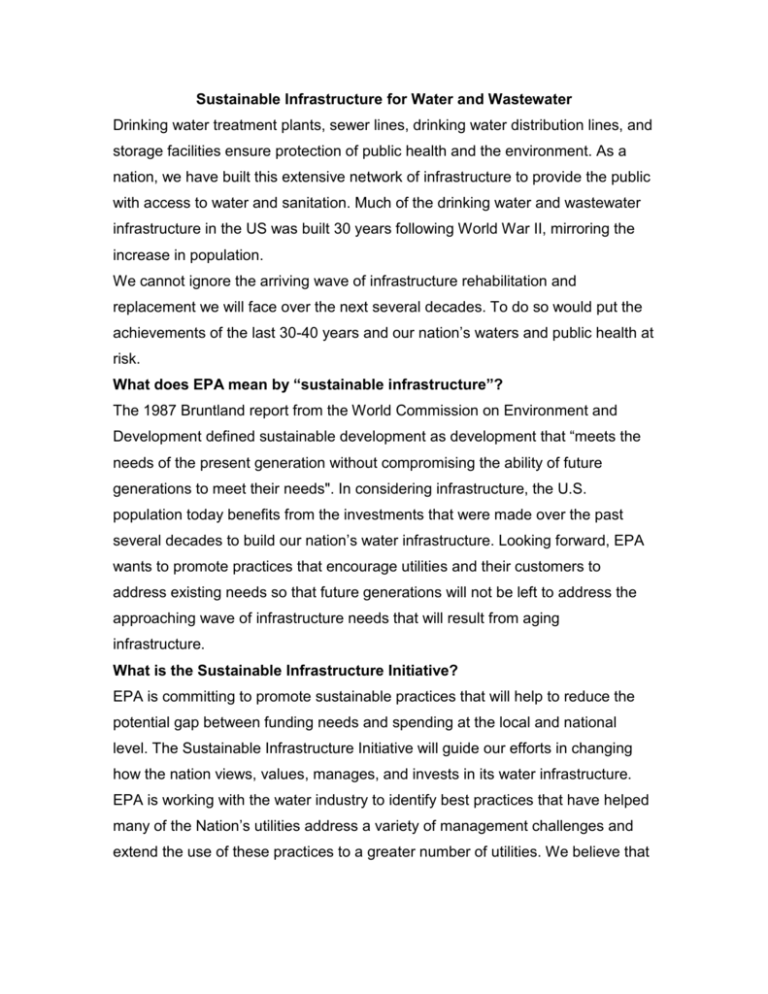
Sustainable Infrastructure for Water and Wastewater Drinking water treatment plants, sewer lines, drinking water distribution lines, and storage facilities ensure protection of public health and the environment. As a nation, we have built this extensive network of infrastructure to provide the public with access to water and sanitation. Much of the drinking water and wastewater infrastructure in the US was built 30 years following World War II, mirroring the increase in population. We cannot ignore the arriving wave of infrastructure rehabilitation and replacement we will face over the next several decades. To do so would put the achievements of the last 30-40 years and our nation’s waters and public health at risk. What does EPA mean by “sustainable infrastructure”? The 1987 Bruntland report from the World Commission on Environment and Development defined sustainable development as development that “meets the needs of the present generation without compromising the ability of future generations to meet their needs". In considering infrastructure, the U.S. population today benefits from the investments that were made over the past several decades to build our nation’s water infrastructure. Looking forward, EPA wants to promote practices that encourage utilities and their customers to address existing needs so that future generations will not be left to address the approaching wave of infrastructure needs that will result from aging infrastructure. What is the Sustainable Infrastructure Initiative? EPA is committing to promote sustainable practices that will help to reduce the potential gap between funding needs and spending at the local and national level. The Sustainable Infrastructure Initiative will guide our efforts in changing how the nation views, values, manages, and invests in its water infrastructure. EPA is working with the water industry to identify best practices that have helped many of the Nation’s utilities address a variety of management challenges and extend the use of these practices to a greater number of utilities. We believe that collaboration with a coalition of leaders, with EPA playing a prominent role, can build a roadmap for the future promotion of sustainable infrastructure. What are the Four Pillars of Sustainable Infrastructure? EPA believes that better management practices, efficient water use, full-cost pricing of water and a watershed approach to protection can all help utilities to operate more sustainably now and in the long-term. 1. Better Management of water and wastewater utilities can encompass practices like asset management and environmental management systems. Consolidation and public/private partnerships could also offer utilities significant savings. Refer to Better Management Folder for more information and materials. 2. Rates that reflect the Full Cost Pricing of service and rate restructuring can help utilities capture the actual costs of operating water systems, raise revenues, and also help to conserve water. Refer to Full Cost Pricing Folder for more information and materials. 3. Resource Efficiency & Renewable Energy is critical. We need to create market incentives to encourage more efficient use of water and energy and to protect and conserve our resources. Refer to Resource Efficiency & Renewable Energy Folder for more information and materials. 4. Watershed Approaches looks more broadly at water resources in a coordinated way, which is challenging because we have not traditionally thought of infrastructure management within the context of water quality protection. Refer to Watershed Approaches Folder for more information and materials. What can be said generally about the age of the nation’s infrastructure? Much of the water infrastructure in the country was built in the period following World War II and it is aging. However, it is important to note that age, in and of itself, does not necessarily point to problems. If a system is well maintained, it can operate over a long time period. Looking at pipes only, an EPA survey found that in systems that serve more than 100,000 people, about 30% of the pipes were between 40 and 80 years old and about 10% of the pipes were more than 80 years old. What is the useful life of infrastructure? Treatment plants typically have a useful life of 20-50 years before they require expansion or rehabilitation. Pipes have life cycles that can range from 15 to over 100 years depending on the type of material and the environment. Looking at pipe, the material used can be a greater indicator of failure than age. Steel pipes installed more than 80 years ago have proven to be much more resilient to failure than pipes made of different materials installed more recently. Why is it so important to properly maintain infrastructure assets? Water infrastructure is expensive as are the monetary and social costs incurred when infrastructure fails, so it only makes sense to make sure that it is properly maintained. If a system is well maintained, it can operate safely over a long time period. A new system that is not properly operated can threaten public health more than an older system that is properly operated. Utilities need to carry out an ongoing process of oversight, evaluation, maintenance and replacement of their assets as needed to maximize the useful life of infrastructure. EPA is focused on encouraging utilities to develop a better way of managing their infrastructure understanding the condition and making risk-based decisions on maintaining and improving infrastructure. What is an example of how poor maintenance could affect water quality and costs? Long-term corrosion of older mains can result in tuberculation, thereby reducing the pipe's carrying capacity. The reduction in carrying capacity requires increasing investments in power and pumping, causing a trade-off between the reduction in hydraulic capacity and the increased operation and maintenance costs to get water from one point to another. Also, bacterial growth within tubercles may cause a potential health problem. Tuberculation also weakens the main by reducing the wall thickness. These reductions in carrying capacity and in strength can increase pumping, breakage, and repair costs, and, consequently, the cost of water delivery Can actions that would fall under the initiative really help address the gap? We believe that utilities can take actions that will reduce their operating costs and thus help to close the gap. Some utilities have made a commitment to addressing their utility in a sustainable manner by implementing a progressive water rate structure with conservation pricing and developing an innovative water efficiency program, which features incentives for the purchase of water-efficient products. These activities have allowed the utility to reduce the overall water demand by more than 20% and they continue to look for savings. These utilities have also used asset management techniques to reduce its FY 2004 capital budget by 13% and its operating budget by 7%. Refer to Infrastructure Gap Folder for more information and materials. (Information provided by the U.S Environmental Protection Agency: January 14, 2010; http://www.epa.gov/waterinfrastructure/index.html) Refer to PDF: Finding a Pathway for Sustainable Water and Wastewater Services Refer to PDF: Primer for Municipal Wastewater Treatment Systems Refer to PDF: Water Infrastructure NOW- Recommendations for Clean and Safe Water in the 21st Century Refer to PDF: 21st Century Wastewater Treatment Technologies Overview Refer to PDF: Sustainable Water Systems- Step One- Redefining the Nation's Infrastructure Challenge
